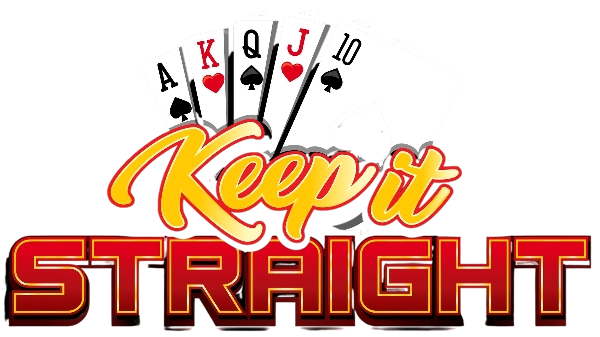If you’re new to poker or just brushing up on hand rankings, one of the most common hands you’ll encounter is the straight. But questions often arise like: Is a straight in poker 4 or 5 cards? or Can a straight in poker be different suits?. In this beginner-friendly guide, we’ll answer all of these questions and help you build a strong foundation in poker hand understanding.
1. What Is a Straight in Poker? Beginner’s Guide to the Hand
A straight in poker is a five-card hand consisting of consecutive cards, such as 5 6 7 8 9. This hand is part of the standard poker hand rankings and sits above three of a kind and below a flush.
Many beginner players confuse the straight with other hands or wonder how strict the rules are. The key characteristics of a straight include:
- Five cards exactly — not four, not six
- Consecutive values (e.g., 6-7-8-9-10)
- Suits can vary; they don’t need to match
Unlike hands such as a straight flush or a royal flush, a standard straight doesn’t require all cards to be the same suit. It’s a balance of accessibility and strength in many poker variants including Texas Hold’em and Omaha.
In terms of poker hand rankings, here’s where the straight fits:
- Royal Flush
- Straight Flush
- Four of a Kind
- Full House
- Flush
- Straight
- Three of a Kind
- Two Pair
- One Pair
- High Card
Knowing how and when to use a straight is an essential skill for any aspiring player.
2. How Many Cards Are in a Straight in Poker?
There’s often confusion around this: Is a straight in poker 4 or 5 cards? The answer is very clear — a straight in poker must consist of five consecutive cards.
Here are a few examples:
- 4 5 6 7 8 → Valid Straight
- 5 6 7 8 → Not a straight — only 4 cards
- 10 J Q K A → Valid straight (also called “Broadway”)
The term “poker hand size” refers to how many cards a legal poker hand contains. For most standard variants, including Texas Hold’em and 5-Card Draw, the rule is always the same: hands are built from 5 cards. This is consistent across all ranked hands, including a straight.
According to PokerNews rules, straights must be exactly 5 cards in sequence. Holding 6-7-8-9-10-J doesn’t make your hand stronger — it’s still just evaluated based on the best 5-card combination.
If you’re holding four consecutive cards and draw another — say you’re on a “straight draw” — the goal is to make that fifth card connect and complete the hand.
3. Can a Straight in Poker Be Different Suits? Explained Simply
This is one of the most common beginner poker questions: Can a straight in poker be different suits? The answer is yes — suits don’t matter when it comes to forming a straight.
For instance, this hand is a valid straight:
7 8 9 10 J
All five cards are in sequence, and they’re not all the same suit. That’s perfectly fine. However, if all five cards are the same suit and in sequence — like 6 7 8 9 10 — that’s a straight flush, a much stronger hand.
So when we talk about poker straight rules, keep this in mind:
- Card value matters — not suit
- Suits can vary in a regular straight
- All five cards must be in order
It’s also worth noting that the Ace can be used either high or low — for example:
- Low Straight (Wheel): A-2-3-4-5
- High Straight (Broadway): 10-J-Q-K-A
But you can’t “wrap” the Ace around — a hand like Q-K-A-2-3 is not valid. This is another frequent error by new players.
Conclusion: Mastering the Straight for Strategic Advantage
To wrap up: a straight in poker is a five-card sequence that doesn’t require matching suits. It’s a moderate-strength hand that beats three-of-a-kind and is beaten by a flush or full house. The rules are simple once you get the hang of them, and mastering straights can dramatically improve your gameplay — especially in popular formats like Texas Hold’em or Omaha.
Remember these key points:
- Always five cards — no more, no less
- Suits can differ
- Aces can be high or low — but not both
- Learn to spot potential straights on the flop and turn
If you’re ready to move deeper into poker hand strategy, check out this hand ranking chart by Upswing Poker for more in-depth resources.
Mastering the straight is just one step in becoming a well-rounded player — and now you’ve got the fundamentals locked in.




